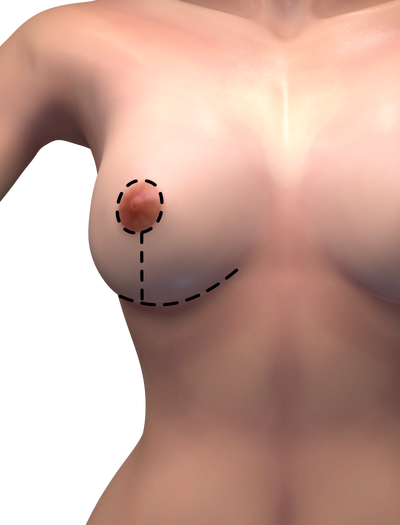The Different Types of Breast Lift Techniques

Sagging of the breasts is a natural occurrence that comes from natural aging, changes in weight, pregnancy, and genetics. Breasts can be affected in terms of firmness, size, or projection. Without support, breasts can hang below the breast fold to the point where the nipples nearly point downward.
Mastopexy (i.e., breast lift surgery) is an effective way to correct sagging or address breasts that appear uneven. A breast lift raises and firms the breasts by removing excess skin and tightening the surrounding tissue to reshape and support the new breast contour. Sometimes the areola becomes enlarged over time, and a breast lift can reduce this as well. Breast lift procedures restore breast projection and improve the shape and symmetry of the breasts.
It is important to note that breast lift surgery does not increase the size of your breasts or round out the upper part of your breast. Those types of results are created through breast augmentation, which is often performed in conjunction with a mastopexy procedure. In fact, breast lifting will often lead to a slight decrease in the perceived size of the breasts. Commonly women report dropping one cup size after breast lift surgery when compared to their preoperative bra size. To learn how breast lift differs from breast augmentation please read this blog post.
There are three common types of breast lift techniques, each differing in terms of the amount of excess skin removed and incision placement:
Traditional breast lift technique
The traditional breast lift technique (sometimes called a Wise pattern or anchor lift) uses three incisions: one incision around the border of the nipple, a second vertical incision from the nipple to the fold under the breast, and a final crescent incision along the breast fold. A traditional breast lift technique is ideal for women that have significantly droopy breast as it allows the surgeon to remove larger amounts of excess skin and tissue.

Vertical breast lift technique
A second technique, called vertical breast lift (also known as a circumvertical or lollipop lift), utilizes the first two incisions of the traditional breast lift (around the border of the nipple and the vertical incision) but not the third crescent incision. The vertical technique is ideal for women with a more moderate degree of sagginess.

Circumareolar breast lift technique
The final technique, circumareolar breast lift (sometimes called a periareolar or donut lift), uses a single incision around the nipple border. Since this technique limits the removal of excess skin and tissue to the area around the nipple, it produces a fairly subtle result. With this technique the nipples can be elevated but internal breast tissue cannot be rearranged. This technique is only useful for women who have a relatively light degree of sagging. This technique also tends to reduce the projection of the breasts and may decrease nipple projection.

Which breast lift technique is right for you?
An experienced board certified plastic surgeon can help determine which technique is most appropriate and would provide the best results for an individual. Surgeons with a vast amount of breast lift experience will look at the degree of sagging, overall breast size, and amount of excess skin to determine the best lift technique.
To learn more about breast lift surgery or to find out if it’s right for you, please contact us to schedule a complimentary consultation.
Disclaimer: The contents of the Westlake Dermatology website, including text, graphics, and images, are for informational purposes only and are not intended to substitute for direct medical advice from your physician or other qualified professional.

Many people don’t understand the difference between Mastopexy and augmentation. Thanks for the article.
I don’t understand the difference between a lift and augmentation. Do you always augment during a lift? Any resources to answer this would be helpful.
Hi Alisa, thanks for reading our post and submitting your question. We did write a great post on the differences between procedures, you can read that here: https://www.westlakedermatology.com/blog/do-i-need-a-breast-lift/
If you have any further questions please feel free to contact us. We do provide free consultations!
Thanks,
WD Staff
Love the pics, very helpful to see the different breast lift options!
Great discussion! I’d like to add that breast implants come in shells that are either smooth or textured. This specific variable of the implant is especially important to consider when doing a breast lift with an implant! Smooth implants have a thinner shell than textured ones. They may be less likely to ripple than textured implants, the surface of which can pull on the implant, causing wrinkling and rippling.
Here’s what we basically cover with our perspective breast lift patients:
Cosmetic surgeons use a variety of incision techniques for breast lift surgery; the exact technique used will vary based on a patient’s existing breast tissue, the amount of excess skin to be removed, and her personal goals. Your cosmetic surgeon will recommend the type of breast lift that will achieve optimal results with the least conspicuous scarring possible.
1.Crescent Lift: Minimal Scarring to Correct Minimal Sagging
2.Peri-Areolar or “Donut” Lift: Corrects Mild Sagging with a Single Scar
3.Vertical or “Lollipop” Lift: Corrects Moderate Sagging & Provides More Extensive Reshaping
4.Inverted T or “Anchor” Lift: Dramatic Reshaping to Correct Extensive Sagging
I’m so confused and going for a third augmentation for larger more projecting breasts. I’ve had two prior Benelli lifts which I feel after my second augmentation it flattened my boobs more which I hate. If that is the case, why do some drs tell me now that that is an option? I have two options with some surgeons, Benelli or donut redo to correct stretched scars or come very to a lollipop and some say full anchor lift. I e come to terms for the lollipop lift but not full anchor.
Again, if “ This technique also tends to reduce the projection of the breasts and may decrease nipple projection” why do some surgeons tell me I have the option or redoing my donut lift if that is the part I hate??